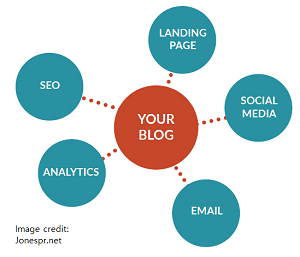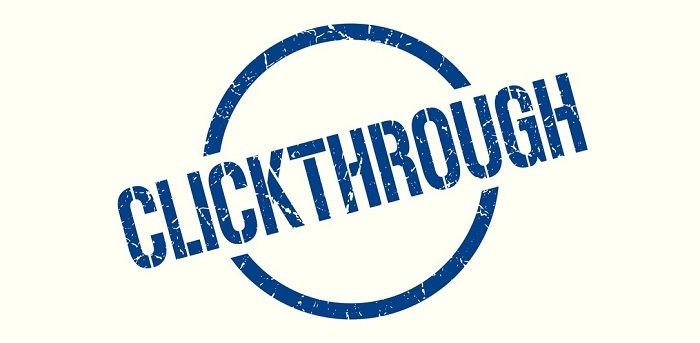For Most Websites, Blogs are Digital Marketing
The reason companies struggle with their marketing is because they don’t give prospects what they want. They say “here’s our stuff” with slick graphics on marketing pages.
That worked 20 years ago, but it doesn’t anymore. The reason Google loves news and blogs is because they’re new, fresh, and packed with information. Specialized marketing pages aren’t. They demotivate the visitor.
For almost all of my clients, the blog is what ranks, attracts and is shareable on social media. Out of the 2 to 5 million visitors I generated for them each, the blog content generated most of their traffic. It’s hard to comprehend at first, but consider your arriving visitors who want to get to know your company, brand and know if you’re credible and trustworthy. And they want to be excited in their own way.
 Many business owners see their blog is something extraneous/frivolous within the process of converting leads. They neglect it because it just isn’t able to “save the day” but nothing may be able to save your tired, traditional marketing pages.
Many business owners see their blog is something extraneous/frivolous within the process of converting leads. They neglect it because it just isn’t able to “save the day” but nothing may be able to save your tired, traditional marketing pages.
The blog with its topics, stories, and engaging copy could be the center of your digital marketing effort and be the workhorse to generate leads. Which means much more of visitor’s experience takes place on the blog. There would be no transition to squeeze pages or marketing pages because your blog would present that information in a more engaging way.
It’s this transition from blog to boring/demanding marketing pages that “must convert now” that visitors leave your site. Pushing people to the marketing page might be the worst decision you can make.
Why is the Blog Correct as the Center of Your Marketing
And as we discuss, if visitors haven’t built enough trust and don’t feel your significant enough, content gaps and jarring transitions are big problem.
Your collective blog posts are engaging, relevant, entertaining and significant. Here’s why the blog must be your marketing centerpiece:
- attracts the most traffic to your site
- visitors look for blog posts to get to know your company and value proposition better (clarity and credibility)
- blog content is more natural, relatable, rich and engaging
- blogs often written by real people with expertise, personalities and reputations
- blogs are fresh, can be kept up to date with new info on topics visitors care about
- blogs have interesting viewpoints and visuals
- marketing pages lose differentiation and make your products/services look common
Your Blog at the Center of Your Marketing Universe

I found a post by a Digital PR firm, Jones PR inspiring. Author Kristin Jones suggest blogs should be the center of a company’s marketing universe (as depicted in their graphic here at right). And while I speak in this post more of content engagement, she adds that when the blog is the center, it generates much more traffic, subscribers and brand evangelists too. But the full value is much greater as I’ll explain.
The PR and branding pros with their high level perspective have learned what holds back company’s marketing performance. The usual thin marketing pages you see on most sites may be their biggest sales killing liability.
Blogs Lead in Powering up Visits
And blog posts combine to generate quite a boost in visits, search engine rankings, engagement, leads, sales revenue and more backlinks for continuously improving SEO power. And when blog content is good, it keeps visitors immersed thus building greater intent and purpose, along with repeat visits.
It may be time to use your business blog as a major, central component of your marketing where your brand experience happens within the blog. For some businesses, it already is. It just needs to be better.
Sound too radical? Well, read on to hear the reasoning and how you might make it happen. And something to consider is that you can do this as an experiment. If anything, you’ll learn a great deal.
Please do bookmark this post, because I’ll be exploring the topic further into content design, strategy, conversion funnel, analytics, and even into AI marketing, so you’re always improving and moving forward with your marketing.
Comprehensive Blog Enrichment
What we’re aiming for is significant blog development and enrichment to make it a comprehensive core of your visitor’s experience. The main point which I might mention repeatedly, is that blog content can be richer, more personalized, specific, refreshed, and news worthy than a product/service package page.
Any animation, video, photo, feature or price list, benefit package, contact person, quote, downloadable, photograph, or chart that’s in your marketing pages/landing pages can also be infused into a blog post.
Currently, marketers try to leverage the blog as a top of funnel component which typically pushes readers through to mid funnel content such as service pages, about us pages, etc. But what if the blog itself contained more of the full funnel?
When visitors transition from page to page, they bounce off the site. That jarring disruption is something even the CRX people don’t study. Visitors lose the scent when the experience is interrupted, and they’re pushed too fast to a dead end. They’re often not ready to buy or subscribe. They need to be engaged in many different ways to generate the right emotions that will help them see your company as most significant.
Engagement then is the real lead generator.
What Does your Blog do Well?
- ranks high on Google creating visits, trust and credibility
- contains specific posts on a topic visitors are keenly interested in
- makes for interesting and lead generating social media shares
- allows your staff to become more transparent, and builds familiarity with visitors
- embodies a full matrix of topics interlinked in a useful way for visitors allowing them to progress as their interest directs them
- contains richer content in news, stories, visuals, data,
- it invites feedback, discussion, additional notes from customers and prospects
- allows you to express your expertise, passion and friendly, collaborative personality (likability)
- makes specific points to create specific emotions in audiences
Your blog presents your company/brand in a rich, personally relevant way. The success of your content strategy is in building this engagement which makes your company the most significant provider.
Blogs Can Generate a More Persuasive Experience
If you examine your site’s visitor stats, you’ll see that more people arrive via blogs, spend more time on blogs, and return to the blog posts again and again. They even arrive on a website and look for the blog. Blog posts generate a higher sales conversion rate, especially older blog posts. Each blog posts is customized portal into your business.
The same can’t be said for your homepage or marketing pages. A sales page or sales sheet tells them what stuff you sell, but that’s not immersive. When people land on price pages too soon, they’re not motivated enough, don’t even yet understand your value proposition, and they bounce quickly. Their content velocity is too fast.
A blog on the other hand provides a selling opportunity wrapped in a pleasant, slower and satisfying content experience. And you can include anything and everything in your blog posts to make them more significant to each type of visitor. You can indicate price points subtly to help erode their price obsession and introduce key people to make it real.
This is not to say that creating this blog as the core digital marketing strategy is easy. It requires more strategic thought, and to look at the full prospect experience differently than tradition. Kristin showed in the diagram how it can be a the center, yet that’s the easy part. The real matter is how will the new arrangement work strategically? What are the details of the process? Your marketer/brand manager will design that flow of content from topics to headlines to links and calls to action.
Can you sell someone so well in the process that they won’t even need to jump to a product/price page or contact us page? This helps you to focus on making the blog better and in scaling up your blog too. Many companies don’t realize they don’t have enough blog content, and much of it is low quality. You have to scale up in every dimension.
The real question/matter is how do you capture and engage them, and make your company the most significant provider for them? That takes a content strategy and mapping out the journey to the blog and the experience within it. The blog can integrate marketing page content, present it better, and keep the visitor engaged longer. The longer they’re on the site, feeling comfortable, the more likely they will become a customer.
Try to sell a customer with a bunch of weak pages, calls to action, and squeeze pressure and you lose them.

Make the Blog an Engagement Destination
Vacation resorts, Disneyland, cruise ships, and shopping malls have all learned that building a destination is key to success. Websites that build a rich content base that makes visits fun, educational and satisfying are the ones everyone links to and cites in news stories.
The trick then might be engage visitors more on the blog and let them enjoy an experience, exhilarating or safe, it’s up to them. Include some conversion elements appropriately within the blog pages themselves (within content sections or a sidebar). The point is to inform them, let them get to know you, explain how your solve their pain points, entertain them fully, then gently let them move through them to your product/service packages page.
That’s not to say that it’s easy to make blogs powerful. And few marketing agencies see blogs as a complete sales solution. They’re still doing it traditional with landing pages and conversion pages.
Respect for the power of the blog is needed first (web stats) then strategy, then very high quality content, and then promotion. Blogs don’t soar for no reason. They need to be designed well.
The blog is where brands get to play and entertain, create transparency and authenticity, and generate emotional connections.
Stats on Blogs: Trust, Leads, Backlinks
- companies that blog receive 67% more leads than companies that don’t
- a blog post frequency of 16+ posts per month generates 3.5 times more website traffic and over four times more leads than companies that publish only a few per month
- blogs create almost 100% more backlinks
- half of B2B customers read 3-5 blog posts before speaking to a salesperson
- 80% of US consumers say they trust what they view on a blog
Stiff, Undifferentiated, Marketing Pages
Over reliance on marketing pages can cripple a marketing effort because they’re not engaging.
Homepages and marketing pages contain stiffly branded content and having them be the focus of your brand experience isn’t wise. These transaction pages are thin and purposefully designed to drive a purchase transaction. They’re usually templated and offer a low engagement level. This is why few customers convert on a landing page. It’s actually insulting to the prospect that a solution is being pushed on them.
Many UX design people have been brainwashed into believing visitors have to detained in the funnel and pushed out the other end (sales desperation). The rise of CRX is because consumers need to build trust, significance, and comfort and will take their time. The rise of these your-money-or-your-life (YMYL) pages has caused Google to punish them and Google appears to be rewarding sites with better engagement and content experiences.
The Blog as the Center of the Website and Social Engagement
Travel sites often use blogs as the core of their marketing and wineries, resorts and hotels should be taking note of that. Travelers don’t easily trust vendors and a price sheet is not a great sales tool. Travelers are looking for experiences beyond an empty hotel room and car rentals. The travel blog helps introduce, build appetites, trust, familiarity, and desire. When the end experience is clearly, confidently established in the travelers mind, they’re ready to purchase and go.
So the point to be made is that your blog (improved to very high quality) should be the focus of your website.
Of course, there are requirements:
- unique value proposition strategy — significant features, benefits, comparisons, emotions, pain points
- blog content strategy — which types of content to feature in them (videos, news, industry events, case studies, customer interviews and success stories)
- interesting, informative, engaging content ideas — which get them to picture scenarios where your product/service is being used
- content ideas, narratives, topics, and opinions — expressed to build trust and likability
- your key people writing — engaging with customers, involved in social media — authenticity and transparency
- keyword strategy and topic themes — for SEO (SEO expertise)
A real estate agent for instance will likely never get a call right away. Home sellers and buyers shop around and if your offer hits the mark, they’ll get around to reaching you. Surveys show people don’t like Realtors and don’t necessarily trust them, or believe they’re worth their commission fee.
Slow Down and Let Visitors Get to Know You
This approach is obviously different from an aggressive sales conversion process with a company that is not transparent. The core word here is trust. People won’t buy until a level of trust is established. And for that, a clear offer, transparent company, proof of value, and longer term engagement is needed.
Calming down your aggressive conversion funnel and taking time to let visitors get to know you might be key to much better performance. This is worthy of investigation for UX designers and beleaguered marketing managers.
 Blog posts are filled with fresh, spontaneous, on-topic and rich coverage of news, insights, perspectives, personalities, and more that engages visitors. They might contain beautiful photos, data, charts, illustrations, videos, quotes, and more that appeal to the emotions of visitors. It’s emotions that drive purchases and customer loyalty.
Blog posts are filled with fresh, spontaneous, on-topic and rich coverage of news, insights, perspectives, personalities, and more that engages visitors. They might contain beautiful photos, data, charts, illustrations, videos, quotes, and more that appeal to the emotions of visitors. It’s emotions that drive purchases and customer loyalty.
While marketers don’t bother too much with top of funnel content engagement, they should be. It might be difficult and require talent, but blogs can deliver impressive numbers of relevant leads and power up the desire to become a customer.
People Return to Blogs to Experience your Brand the way they Really Want to Experience It
Customers return to blogs to re-experience them — and to re-experience your brand. They want to enjoy the content more, get more comfortable, gain more insight, clear up details and questions, and validate their belief in your company and brand.
The blog nurtures the human, emotional and comfort aspect of selling.
Few return to a homepage or a marketing page. That tells you a lot, and why you need to develop your blog to its fullest extent possible. If you’re not converting leads or seeing them progress through the funnel, then it could mean visitors aren’t achieving the brand experience they actually want.
The blog’s freshness, unique targeted approach and wide visibility mean it should be awarded much greater respect, not as a doorway page, or support for your other pages, but as a destination itself. A blog post can contain any kind of engaging content from videos to stories to insights. When this content is presented within a fascinating branded storyline to readers, it can build a strong connection.

Besides the arrival of hundreds of thousands of visitors from your Google rankings, blogs can help make your link building, social media posting, and news releases more effective. Google in particular is more interested in news stories and blogs than in thin marketing pages. Still, most marketers see blogs differently. Perhaps it’s time to upgrade that perspective on blogging completely and see blogs as the awesome content experience they can be.
Large Companies Are Giving You an Opportunity
Large company’s focus on direct advertising leads and their neglect of generating new visitors via the blog though, gives smaller upstarts an opportunity to win new customers and keep them loyal. Only, when bigger businesses fail, do they begin to look at the power of SEO and blogs. But still, they fill them with thin content — a doorway page. That’s why your small business blog could enjoy a lasting advantage.
Research on blogs is fairly compelling. As poorly designed as they are, they still launch sales. In fact, old blog posts are considered the most effective sales performers.
Big companies and brands tend to focus on and feature their marketing pages and homepage. That’s the traditional digital marketing strategy. They often have ads, sponsorships, remarketing campaigns, and other channels that push visitors directly to those pages. We’d call these “return visitors” or “low hanging fruit” who are already familiar with the brand, but just need stronger messaging to push/squeeze to purchase (despite turning many off).
Blogs Can Deliver Millions of Visitors
Many business owners don’t realize some businesses have blogs that generate millions of visitors. Google and Bing still want to present your blog posts to searchers, but you have to do something to pass search engine algorithm filters.
Using advanced SEO techniques, and the rich keyword and topic content in blog posts they rank well on Google. Some are designed to be evergreen, yet refreshed to make them very relevant now to readers. It’s this complex richness that gives advanced SEO strategists their capacity. But it is skill and expertise that creates top ranking results.
The point of this post on the power of blogging is more of a pep talk to encourage you to put more resources into your blog and to feature it. You should develop it as a fully functioning customer service center, not as an appendage that you don’t want anyone to see.
Videos, trade show events, beautiful photos, customer success stories, success tips, customer acknowledgement, and illustrations can combine to present a rich, compelling, three dimensional, presentation of your company, products, employees, management, and customer base.
The full value of being your customer isn’t easily apparent on your website. It takes new fresh content experienced by them over time to build this certainty about your brand.
Advanced SEO | SEO Company | Digital Marketing Service Packages | State of SEO Report | Realtor Marketing Packages | California SEO | SEO Services | SEO Boston | Backlinks Building Company | How to Achieve High Rankings | Contact Gord Collins







